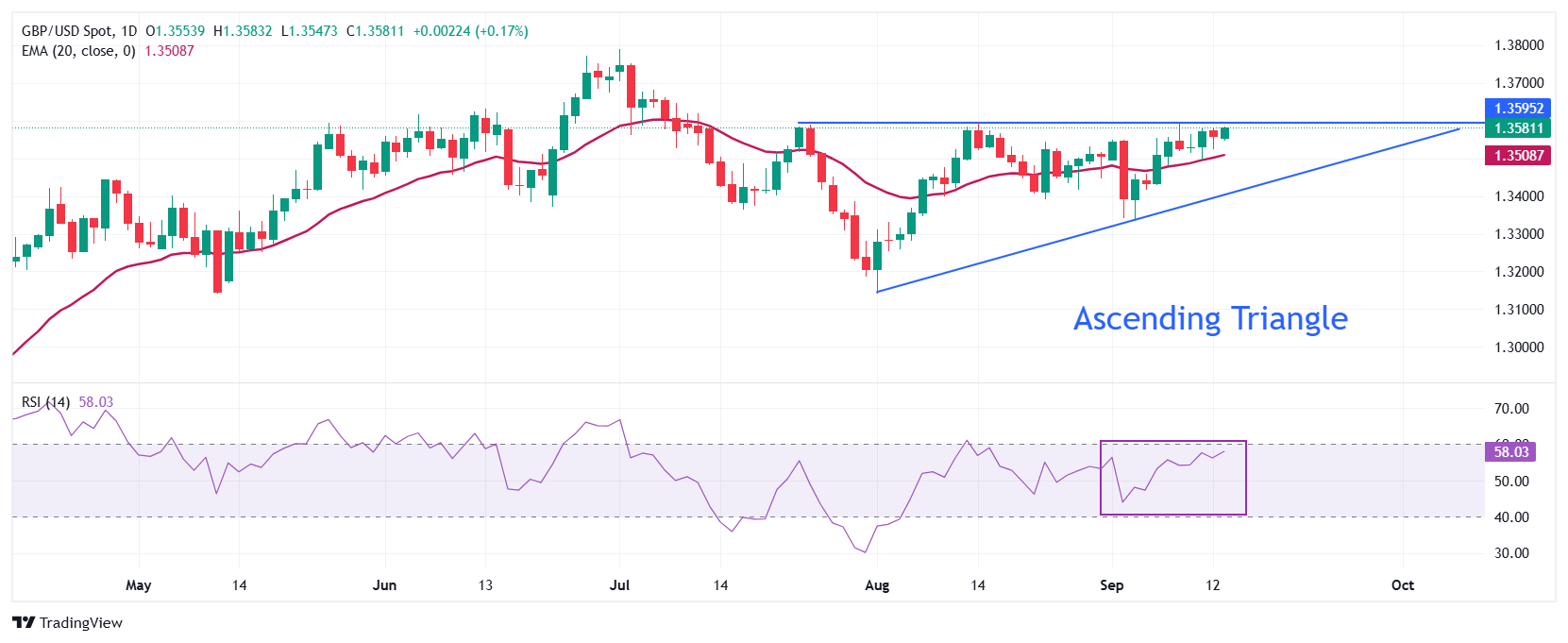Pound Sterling gains ahead of Fed and BoE monetary policy decisions
- The Pound Sterling rises at the start of the week ahead of the Fed and BoE monetary policy announcements.
- Investors expect the Fed to cut interest rates, while the BoE is seen holding them steady.
- UK headline CPI is estimated at a faster pace of 3.9% in August.
The Pound Sterling (GBP) trades higher at the start of the week against the US Dollar (USD) during the European trading session. The GBP/USD pair rises to near 1.3580 as the US Dollar trades cautiously, with investors awaiting monetary policy announcements by the Federal Reserve (Fed) and the Bank of England (BoE) on Wednesday and Thursday, respectively.
During the press time, the US Dollar Index (DXY), which tracks the Greenback’s value against six major currencies, trades marginally down near 97.50.
According to the CME FedWatch tool, traders see a 94,2% chance that the central bank will cut interest rates by 25 basis points (bps) to 4.00%-4.25% in the policy announcement on Wednesday. Fed dovish speculation has been intensified due to growing labor market concerns.
Meanwhile, the BoE is expected to hold interest rates steady at 4% as inflationary pressures in the United Kingdom (UK) economy are continuing to prove persistent.
Daily digest market movers: Investors await key US-UK economic data
- Investors brace for a significant volatility in the Pound Sterling this week as the United Kingdom (UK) labor market data for three months ending July and the Consumer Price Index (CPI) data for August are also scheduled to be released this week on Tuesday and Wednesday, respectively.
- The Office for National Statistics (ONS) is expected to show that the ILO Unemployment Rate remains steady at 4.7%. Average Earnings Excluding Bonuses, a key measure of wage growth, is estimated to have grown at an annual pace of 4.8%, slower that the prior reading of 5%. However, the wage growth measure including bonuses is expected to have risen at a faster pace of 4.7 from the former reading of 4.6%.
- Lately, BoE Governor Andrew Bailey has warned of downside labor market risks and guided that the monetary policy path will remain downwards.
- Meanwhile, the UK headline CPI is expected to have risen at a faster pace of 3.9%, the highest level in 19 months. BoE officials would need to perform a delicate balancing act if the inflation data shows signs of growth and the labor market faces slowdown.
- In the US, investors await the Retail Sales figures for August, which will be published on Tuesday. The US Retail Sales data, a key measure of consumer spending, is expected to have grown at a moderate pace of 0.3% against 0.5% in July.
Technical Analysis: Pound Sterling stays above 20-day EMA

The Pound Sterling edges higher to near 1.3580 against the US Dollar on Monday. The near-term trend of the Cable remains sideways as it trades close to the 20-day Exponential Moving Average (EMA), which is around 1.3508.
The Cable trades inside the Ascending Triangle chart pattern, which indicates indecisiveness among investors. The horizontal resistance of the above-mentioned chart pattern is plotted from the July 23 high around 1.3585, while the upward-sloping border is placed from the August 1 low near 1.3140.
The 14-day Relative Strength Index (RSI) oscillates inside the 40.00-60.00 range, indicating a sideways trend.
Looking down, the August 1 low of 1.3140 will act as a key support zone. On the upside, the July 1 high near 1.3800 will act as a key barrier.
Pound Sterling FAQs
The Pound Sterling (GBP) is the oldest currency in the world (886 AD) and the official currency of the United Kingdom. It is the fourth most traded unit for foreign exchange (FX) in the world, accounting for 12% of all transactions, averaging $630 billion a day, according to 2022 data. Its key trading pairs are GBP/USD, also known as ‘Cable’, which accounts for 11% of FX, GBP/JPY, or the ‘Dragon’ as it is known by traders (3%), and EUR/GBP (2%). The Pound Sterling is issued by the Bank of England (BoE).
The single most important factor influencing the value of the Pound Sterling is monetary policy decided by the Bank of England. The BoE bases its decisions on whether it has achieved its primary goal of “price stability” – a steady inflation rate of around 2%. Its primary tool for achieving this is the adjustment of interest rates. When inflation is too high, the BoE will try to rein it in by raising interest rates, making it more expensive for people and businesses to access credit. This is generally positive for GBP, as higher interest rates make the UK a more attractive place for global investors to park their money. When inflation falls too low it is a sign economic growth is slowing. In this scenario, the BoE will consider lowering interest rates to cheapen credit so businesses will borrow more to invest in growth-generating projects.
Data releases gauge the health of the economy and can impact the value of the Pound Sterling. Indicators such as GDP, Manufacturing and Services PMIs, and employment can all influence the direction of the GBP. A strong economy is good for Sterling. Not only does it attract more foreign investment but it may encourage the BoE to put up interest rates, which will directly strengthen GBP. Otherwise, if economic data is weak, the Pound Sterling is likely to fall.
Another significant data release for the Pound Sterling is the Trade Balance. This indicator measures the difference between what a country earns from its exports and what it spends on imports over a given period. If a country produces highly sought-after exports, its currency will benefit purely from the extra demand created from foreign buyers seeking to purchase these goods. Therefore, a positive net Trade Balance strengthens a currency and vice versa for a negative balance.
